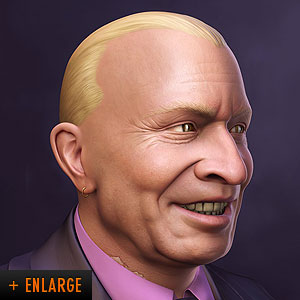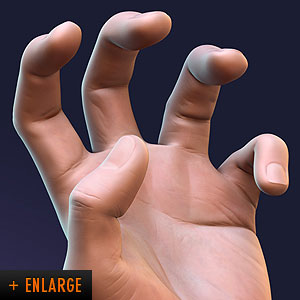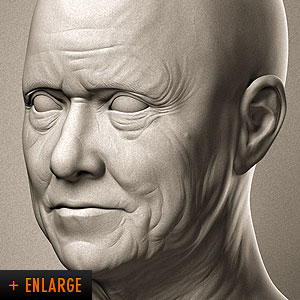
Tell us a little about yourself?
I am a 3D artist who has relocated to Paris. I primarily work on characters and creatures for the movie industry, the game industry, as well as commercials.
How did you first discover ZBrush?
I discovered ZBrush in 2000. At that time, the software was less evolved than it is today, in regards to its tools for sculpting and modeling in 3D, even the number of polygons it could handle. ZBrush was already very fast and an interesting technology with loads of potential but I was not ready to incorporate it into my daily workflow.
In October 2003, I became a member of the beta team for ZBrush 2. After months of seeing the images generated by Dave Cardwell (from Weta) even though the new functions were still confidential, I began to fully realize the technological innovation that was born in 2001 and the fantastic possibilities for a digital artist like me.
I then began to use the ZBrush 2 Beta in 2 full movie productions: RRRrrr – at Duboi and Renaissance at Attitude Studio, fully exploiting, and seeing first hand ZBrush's evolution unfold.
"ZBrush has totally changed the way I create a 3D model. ZBrush is much more natural, fast and simply is the closest thing to actual sculpting."

What were your reasons for using ZBrush and how would you rate ZBrush's contribution to your workflow?
ZBrush has totally changed the way I create a 3D model. ZBrush is much more natural, fast and simply is the closest thing to actual sculpting.
For example: Using ZBrush on a project I am doing, I was able to create multiple characters all very different from each other using the same mesh as a base, which saved me enormous amounts of time. Each model was then sculpted in ZBrush so that I could quickly add details such as wrinkles and folds, that otherwise would have had to be done in a classic modeling approach/method. To finish, each displacement map was generated and extracted from each model and applied at rendering time.
What is your favorite new feature or features of ZBrush?
Without a doubt, ZBrush's most outstanding new feature for me is to take a low-resolution model, subdivide it into several millions of polygons, sculpt in real-time, then generate, and extract a displacement map.
Next to that, there are many new functions like using "Projection Master" to sculpt a model, or the mesh reconstruction...I guess I could just list all of the new functions!

Would you recommend ZBrush to other artists, and why?
Absolutely! To produce organic models it enables me to create differently than any other standard 3D applications currently available. From the standpoint of a digital artist, ZBrush fits perfectly in any film production pipeline and can be a complimentary companion to software like Maya for instance.
For a traditional artist, ZBrush is the program that most resembles natural sculpting, like sculpting with clay. Thanks to the ZSpheres, it is now possible to block a simple base shape that can be easily modeled, sculpted, and detailed. Working with ZBrush is quite fluid and easy.
Overall, ZBrush is the only software available that allows sculpting of a 3D model with so much speed and flexibility; and is the only software that enables so many details and such refinement on a 3D model. It also lets you create sceneries and illustrations, which blend 2D and 3D in one environment.
Do you plan to incorporate ZBrush in future projects?
Yes, of course! I will use it every time I have to create 3d models that need attention to details for films, commercials and video games and I plan to use ZBrush more and more for my illustrations.


